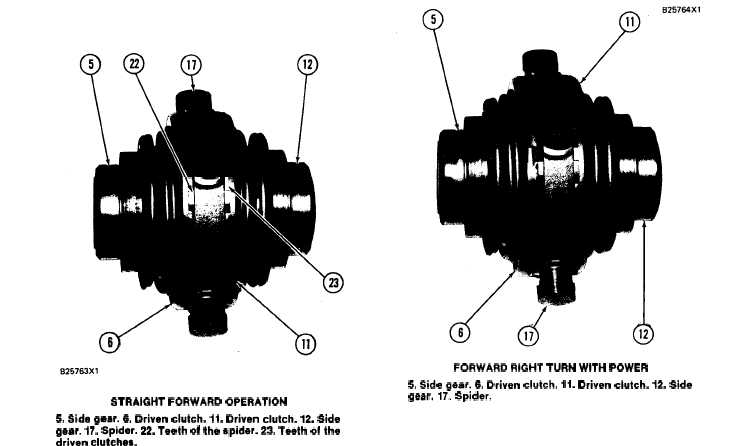P O W E R T R A I N
N O S P I N D I F F E R E N T I A L G R O UP
Straight Forward Operation
TM 5-3805-258-24-1
S Y S T E M S O P E R A T I O N
STRAIGHT FORWARD OPERATION
5. Side gear. 6. Driven clutch. 11. Driven clutch. 12. Side
gaar. 17. Spider. 22. Teeth of the spider. 23. Teeth of the
driven clutches.
When the machine has straight forward move-
ment, teeth (22) on both sides of spider (17) are fully
engaged with teeth (23) of driven clutches (6) and
(11). The teeth of cams (21) are engaged with the
teeth of center cam (15). The negative angle of the
teeth on the clutches and spider, along with the force
of springs (7) and (11), cams (21) and center cam
(15), push together and the teeth engage.
In this condition, driven clutches (6) and (11) are
fully engaged with spider (17). The driven clutches
turn side gears (5) and (12) at the same speed as the
bevel gear. The two side gears turn the axle shafts
and wheels at the same speed as the bevel gear.
Forward Turn With Power
The travel of the outside wheel, during a turn, is at
a longer distance than the travel of the inside wheel.
When the machine turns with power, the NoSpin
differential lets the outside wheel turn faster than the
speed of the bevel gear (to let the outside wheel have
this longer travel) but does not let the inside wheel
turn slower than the speed of the bevel gear. The
inside wheel turns at the same speed as the bevel
gear.
FORWARD RIGHT TURN WfTH POWER
5. Side gear. 6. Driven clutch. 11. Driven clutch. 12. Side
gaar. 17. Spider.
The teeth of the spider send the drive force to the
inside driven clutch. The inside driven clutch turns
the inside wheel at the same speed as the bevel gear
and gives the power that is needed to move the ma-
chine through the turn.
The outside wheel is made to turn (by the traction
of the road) at a speed faster than the speed of the
bevel gear. This causes the driven clutch for the
outside wheel to turn faster than the speed of the
bevel gear. The movement of one wheel faster than
the other wheel starts the “clutch action” of the
NoSpin differential.
The teeth of the cam for the driven clutch for the
inside wheel are engaged with the teeth of center cam
(15) and stay in the same position in relation to
spider (17). The teeth of the inside drive clutch are
engaged with the spider. The teeth on the other side
of center cam (15) are used as ramps. The teeth of
the cam for the driven clutch for the outside wheel
move up the teeth of the center cam. This causes the
outside driven clutch and cam to move away from the
spider and center cam. The outside driven clutch and
arm are not engaged with the spider and center cam.
3-57

